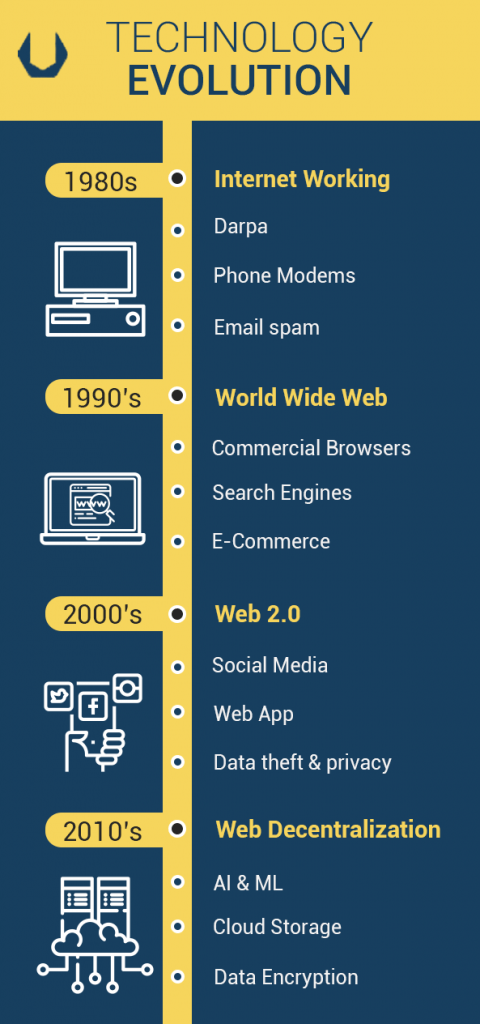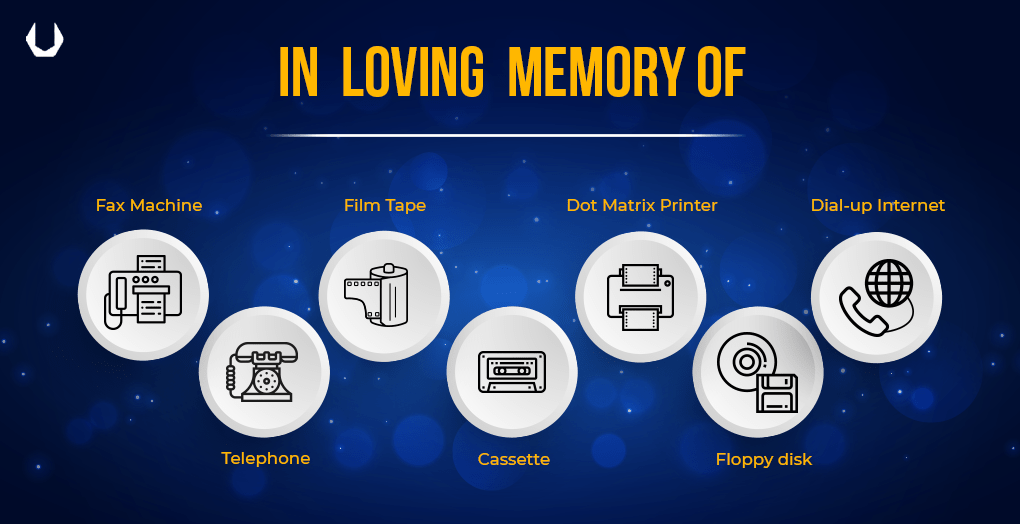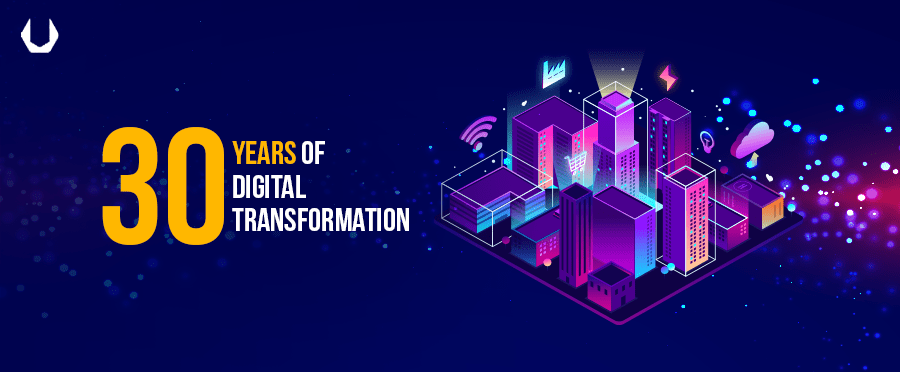Why reminisce, you ask? As you move forward, it’s never a bad idea to look back, right? To set the context, let’s just reiterate that it’s been close to 20 years since the Y2K cooked up a storm. (We’ll give you a minute to let the nostalgia kick in!) Over the last few decades, as people who are thoroughly invested in the digital ecosystem, we’ve had a lot of keeping up to do. Whether a change effort was automatic or pre-determined, ‘digital transformation’ has (re)shaped industry after industry.
It’s really surreal to see how far we’ve come! In fact the growth of the digital landscape, cannot be separated from the developments in technology. For instance, as personal desktops and the number of internet users soared, businesses immediately started thinking about how the new technology can accelerate their growth. Simply put, digital has essentially transformed the way businesses interact with their customers and vice versa. So, let’s sit back, and take a look at the milestones of the yesteryears, shall we?
Table of Content
1. Websites Dynamics
Amidst the current talks of 5G internet speeds, the 90s (with dial-up internet) now seems like the dark ages. Things weren’t easy, and to say that it was difficult to build websites was an understatement. But to give credit, the 90s websites did enjoy the spotlight with the introduction of Mosaic (Netscape), the first popular graphics-based web browser for the World Wide Web. Even though the internet was prevalent in the 80s, Netscape was the one to commercialize and capitalize on the World Wide Web, showing businesses what the internet was capable of. And everyone wanted to jump on the bandwagon because of the sheer opportunity that it presented! Businesses wanted to build websites, pack information and reach the customer.
User-Generated Content
With the birth of Web 2.0 in the 2000s, user-generated content came to the forefront, and we saw so many renditions of website content. People were creative and quirky, and we truly embraced the internet, with all its rough edges. Content creation saw a boom, it was such a big deal because websites were static in the 90s giving no freedom to the users. It was called the ‘Age of the Internet of People (IoP)’ – people were able to lead ‘virtual lives’ surpassing geographical borders in their communication. This led to the growth of forums and email marketing, businesses saw an opportunity, suddenly, they could have conversations with their customers. And, that led to a shift in dynamics.
Social Engagement
In the late 2000s and early 2010s, we saw how artificial intelligence, machine learning and the internet of things (IoT) led to the birth of the third generation of websites. User interaction was pushed to the limits, with personalization and customization (yes, we do acknowledge the privacy issues, but we’ll deal with that later). And, user-generated content went to a whole new level with social networking sites. The web of today is interconnected, creating a seamless rendition of data across borders.
For businesses, social media acts as a roulette wheel of instant communication. It allowed companies to be a part of the ‘public’, and provides a platform to promote products/services and have transparent messages on its performance. So again, websites became dynamic enough to support this engagement ecosystem with tech-savvy businesses taking their businesses not only digital but truly social – to have their own customers talk about their products, what a genius masterstroke!
Coming of Age: Web Browsers
Diving into browsers, back in the late 90s we had Internet Explorer, NCSA Mosaic and Netscape. These browsers were so unstable, with repeated crashes. In 20 years all that has changed, we now have solid options like Safari, Firefox, Chrome and Edge (overhauled IE), while there are still a few clinks, they are far from the disasters they once were.
2. Design Sense and Aesthetics
Where do we start with this one? As the websites went through a makeover, so did their respective designs. Today, in the age of UI / UX, we all drool over motion graphics and animated banners. But do you remember when the Html marquee was such a big deal?
Drift From Block Text
While we now emphasize on negative space, back in the 90s and early 2000s websites were covered with colorless text without an inch of free space. We really can’t blame the designers of the 90s, they didn’t have much else to play with other than Html; which was primarily created to only handle text and was nowhere close to the refinement it has today. Yes, designers eventually started using tables and frames to break the content, but it still was an “awkward time”.
Seasoned Tools of Trade
So you can imagine the excitement when Macromedia (later taken over by Adobe) first launched Dreamweaver. Speaking of Adobe, how can we not talk about the acclaimed Photoshop. For those of you who have only ever known CS3 versions and above, know that navigating and working on the versions in the late 90s and early 2000s were a nightmare.
It’s not like we lived in a time with no design sense, it’s more like that’s all we had to work with! The 90s and 2000s seemed like difficult times because of several limitations. For instance, designers would only get about 50kb of space for a homepage, anything more would lead to slower load times because of the internet speeds. They also had a serious lag in resolutions, our smartphones now have a higher resolution than a desktop monitor of the 90s! And, it’s not like we had WordPress or responsive layouts! So, it was an age of small wins really.
Oh, Flash!
Creative communication took a whole new turn with the birth of Flash in the 90s. Animation and vector graphics were combined to create Flash. We saw graphic elements on websites with moving pictures, videos and music! However, the issues started almost instantly. Flash was prone to malware attacks leading to heavy breaks. But that didn’t deter people, Macromedia issued constant updates, and soon by the early 2000s entire websites were built on Flash. The biggest sell was the custom UI panels that really took design sense to another tangent. Finally, designers could play, and oh, how they loved it! To be honest, despite all its clinks flash was the stepping stone for interactive user experience.
When Adobe took over Flash in 2005, it seemed like promising times were ahead. Google took to Flash, even launching Youtube based on it. But sadly the high didn’t last for long, Apple decided to disassociate itself from Flash in 2007, and eventually, so did Google in the decade that followed. By 2018, the total number of websites that still used Flash dwindled to 7%. This leaves Adobe with a serious moral dilemma – is it still worth it to run technical support for a dying technology?
The Trifecta – CSS, Java & html5
While we were taking Flash out for a spin, JavaScript (and its technical support in web browsers) began to improve significantly. Java was used to create movement in websites, literally! When you see dynamic boxes, interactive maps, animated layout, and images, know that Java’s behind it!
While we saw movement, we also saw style. The concept of style sheets was never new, but CSS managed to bring the separation between content structure and layout. With CSS you could apply a single style rule to define html content on a page or the entire website, without having to repeatedly touch the content – Very handy, and very effective. Along with CSS and Java, Html5 saw the birth of the golden age of website design. HTML is a markup language that has today managed to glorify the way we see and interact with websites, it gives structure, helps embed videos and images. It also helps improve functionality and eventually led to the blurred lines between websites and apps.
3. Mobile,‘Smart’ Technology and IoT
Mobile technology and smartphones need no introduction. Let’s just say that when the curveball was hit in the 90s, a parabola of technological advancement followed right from touchscreens, AI, augmented reality and smart technology. We saw movement from watered-down versions of desktop sites to amp sites and then responsive layouts, which soon became the norm. This led to a very tangible shift of the internet, and of course the birth of Web 3.0. But the interesting part is how the internet has evolved to adapt with smart technology. We can see mobility and connectivity surpass the traditional boundaries of laptops and tablets and include anything from shoes to wallets, sunglasses, and cars, the list is quite endless (and exhausting).
This also presented the challenge and the constant demand for developers and the infrastructure to support such a scale of data exchange and communications. This moved businesses (whether of B2B or B2C) to invest more in mobile technologies and data integration creating a new world of responsive applications, actionable real-time insights, and personalized web-services. Mobile and mobility are now interrelated and integral to an interconnected world.

4. e-Commerce Boom
How fast is e-commerce growing? Lighting fast! The Indian e-commerce industry alone is predicted to reach a whopping US$ 200 billion by 2026. Long before the word e-commerce was coined, in 1982 a company called the Boston Computer Exchange created an online platform to sell their used computers. 13 years later, in 1995 Amazon and eBay were launched, and they were initially envisioned as an online marketplace, a way for customers to become vendors and reach a global audience. The growth of e-commerce in the 90s led to a massive realization – an online marketplace also meant that online advertising was possible. This realization completely changed the way we saw traditional marketing.
In the decade that followed, we saw a two-phase growth on how businesses grew digitally. On the one side, we saw the growth of commerce platforms take hold (Magento, Shopify), the introduction of digital payment methods (Paypal, Google Wallets) and an increase in digital brand storefronts. On the other side, we saw advertising & marketing opportunities grow for businesses. In 2000, Google introduced Adwords, and in 2011 Facebook introduced sponsored content, creating the basis for digital marketing as we know it today.
The e-commerce boom truly had a ripple effect on how we interact with the digital economy. Small business saw opportunities like never before, and larger traditional businesses were forced to transform digitally.
5. It all Waters Down to Cloud
Growing up the only cloud we knew were rain clouds, and for it to eventually mean data storage was unthinkable. When was the last time you used a USB? Today, business operations are based on cloud implementation. Right from simple things like Google docs to crazier things like hosting. With cloud storage and hosting we started seeing better control, reliable data transmission and an online infrastructure that promotes scalability.
Bidding Adieu
The dynamics of digital is changing every day. Despite what the future holds, it sure looks promising. However, one thing is certain, Machine learning and Artificial intelligence will continue to be the forces that disrupt the business world. On a lighter note, just like how we are belittling the 90s dial-up connections, imagine how 5G speeds might be the butt of jokes in 30 years! And, in the true spirit of saying goodbye, let’s leave you will some loving memories!


